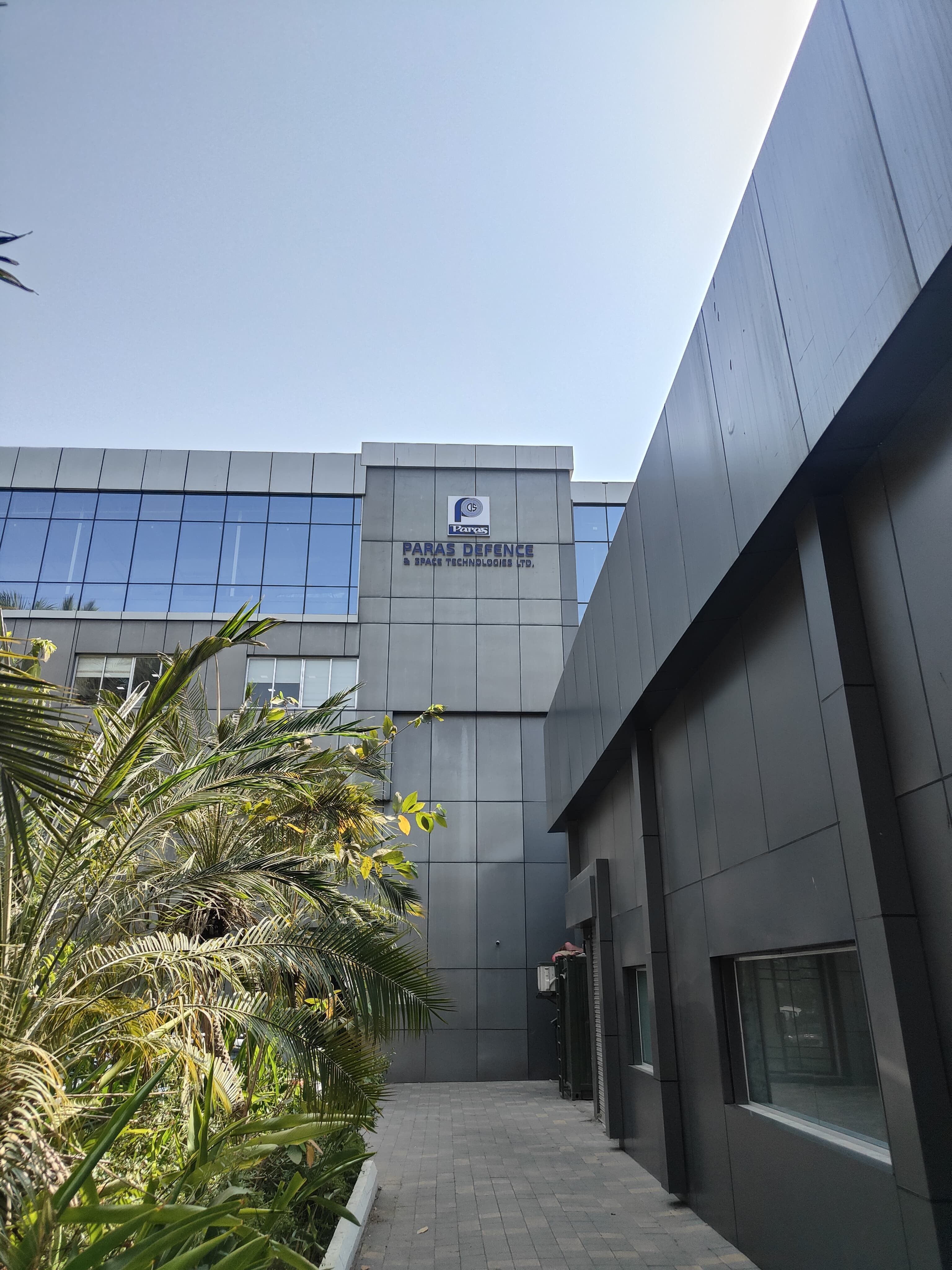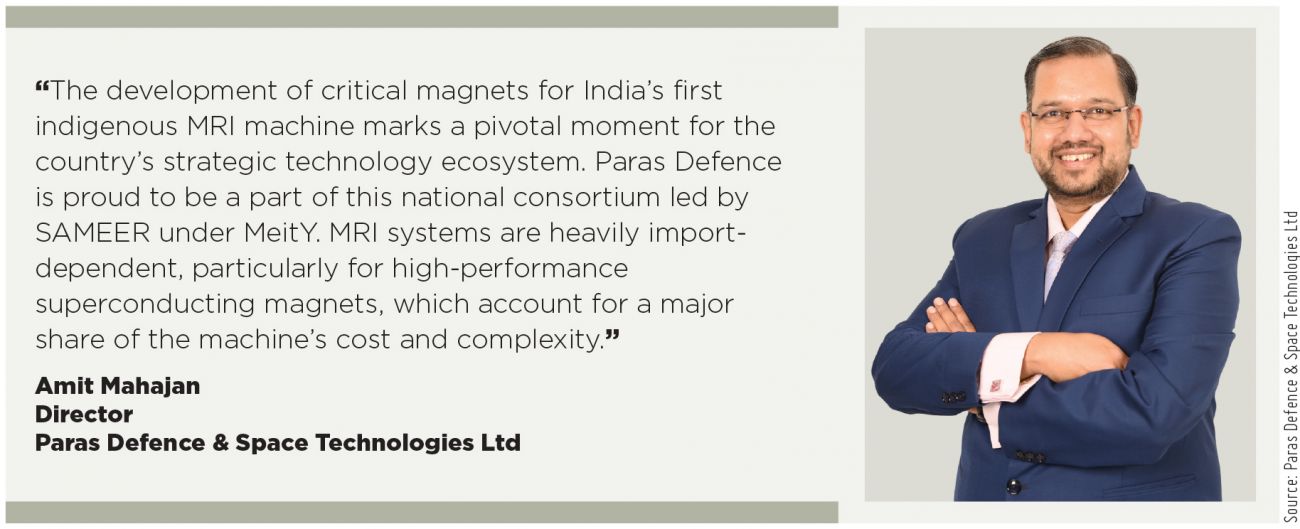POWERING INDIGENOUS DEFENCE CAPABILITIES

Amit Mahajan, Director, Paras Defence & Space Technologies Ltd, in this insightful interview with MMI’s Editor-in-Chief, Soumi Mitra, sheds light on the company’s core strengths and its role in advancing India's indigenous defence manufacturing capabilities. He also shares the goal of being a leading hardware technology enabler to support the armed forces in this evolving era of hybrid warfare.
Paras Defence specializes in advanced Optronic Systems for Defence and Space, Defence Electronics, Electromagnetic Protection Solutions, and Heavy Engineering. Could you elaborate on the company’s core strengths across these domains for our readers?
Paras Defence’s operations are anchored in two core verticals optics and optronic systems and defence engineering, which include defence electronics, electromagnetic pulse (EMP) protection solutions, and heavy engineering. We are the only Indian company manufacturing optronic periscopes in the Asia-Pacific region for submarine applications, enabled by all-round capabilities in optics design & manufacturing and electronics & mechanical system engineering for Naval applications. Our technological footprint spans rockets, missiles, naval platforms, armoured systems, ISR (Intelligence, surveillance and reconnaissance) and space applications. In optics, we offer day/night sights, EO (electro optical) systems, and imaging payloads for unmanned aerial vehicle (UAVs) and satellites.
Under Defence electronics, our portfolio covers high-performance embedded computing and ruggedized electronics for missiles and electronic warfare (EW) platforms. Our EMP vertical ensures secure operations via shielding, TEMPEST systems which are used to prevent electronic eavesdropping, and Faraday enclosures that are designed to block electromagnetic fields.

Through our group entities, we are expanding into next-gen domains. Paras Anti-Drone develops integrated counter-drone systems and specializes in radio frequency (RF) and microwave technologies and Quantico Technologies intend to develop solutions in Quantum Communication & Quantum Sensing.
Paras, in partnership with Israel’s CONTROP, manufactures EO/IR gimbals. It recently launched a new line of indigenously built drone cameras for military and paramilitary use. Our JV with Israel’s HevenDrones is aimed at co-developing heavy-lift autonomous drones, including hydrogen-powered platforms for long-range missions. These partnerships combine indigenous R&D with global tech to reinforce our position as a full-spectrum player in India’s defence and space ecosystem.
You’re the only Indian manufacturer of optronic periscopes in the Asia-Pacific region. How did you build this unique capability, and how do you maintain the technological edge?
India has long relied on foreign suppliers for critical defence technologies, including submarine periscopes, which are essential for underwater surveillance and situational awareness. Recognizing the strategic imperative of self-reliance, Paras Defence has committed itself to developing indigenous solutions to reduce this dependency.
In 2022, the Defence Research and Development Organisation (DRDO), through its Instrument Research & Development Establishment (IRDE), transferred the technology for optronic submarine periscopes to Paras Defence via a licensing agreement. This transfer marked a significant milestone, positioning Paras Defence as the first Indian company to manufacture these sophisticated systems on a turnkey basis.
Building on our extensive experience in defence electronics and optics, Paras Defence has successfully integrated advanced sensor technologies, image processing units and human-machine interfaces to develop state-of-the-art optronic periscope systems. These systems are designed to meet the stringent requirements of modern naval operations, enhancing the stealth and operational effectiveness of Indian submarines. This achievement underscores Paras Defence’s commitment to import substitution and its role in advancing India's indigenous defence manufacturing capabilities.
|
‘Operation Sindoor’ highlighted India’s growing defence manufacturing strengths with successes like the Akashteer air defence system achieving a 100 percent intercept rate and effective use of indigenous drones such as SkyStriker and Nagastra. These milestones showcase the impact of ‘Make in India’. |
Can you shed light on how your in-house R&D ecosystem drives product innovation across such diverse domains—from missile systems to thermal space solutions?
At Paras Defence, in-house R&D is the nucleus of our innovation journey and the foundation of our ability to deliver strategic technologies across defence and space. Our R&D ecosystem is collaborative and interdisciplinary, bringing together experts in optics, electronics, embedded systems, mechanical engineering and material sciences to co-develop cross-platform solutions.
We have made substantial investments in simulation tools, prototyping labs, and specialized testbeds, enabling rapid iteration from concept to deployment. This allows us to engineer high-reliability systems for applications ranging from missile-borne rugged electronics, control systems, and telemetry to EO payloads for UAVs and thermal shielding structures for satellites.
Our research spans both current requirements and emerging threats. In fast-evolving domains like electronic warfare, drones, and anti-drone systems, indigenous R&D is not just a differentiator, but a strategic necessity. We are actively developing jamming-resistant UAV platforms, miniaturized EW systems, image fusion algorithms, adaptive counter-drone technologies and radiation-hardened electronics for multi-domain use.
We also work closely with agencies like DRDO, Indian Space Research Organisation (ISRO), and the Society for Applied Microwave Electronics Engineering and Research (SAMEER) and collaborate with the private sector primes on national programmes to co-develop subsystems. By controlling the entire innovation cycle—from design and simulation to manufacturing and field-testing—we ensure our solutions are cutting-edge, scalable, and mission-ready for India’s defence needs.
| Since 2019, the evolution of Foreign Direct Investment (FDI) norms has created a conducive environment for indigenous development by encouraging technology transfers, joint ventures, and greater capital inflows. This policy shift lays the foundation for rapid growth and innovation in the defence sector. |
Please elaborate on how Paras Defence contributes to India’s push for defence indigenization, and what more needs to be done to accelerate this mission?
Paras Defence is deeply aligned with the goals of 'Atmanirbhar Bharat' in defence. Over 75 percent of our product value chain is indigenous. We have successfully replaced many imported systems with Indian alternatives—be it electro-optical sights, control electronics for missile launchers, or electromagnetic interference (EMI) shielded systems for C4I applications. Our partnerships with DRDO, DPSUs and private OEMs help scale indigenous systems across platforms.
However, accelerating this mission further requires stable long-term procurement pipelines, increased R&D grants for private sector innovation, and the swift implementation of Indigenously Designed, Developed, and Manufactured (IDDM) category contracts. A unified technology roadmap led by the Ministry of Defence (MoD) and DRDO, with the private industry as a co-developer not just a supplier can further propel self-reliance. Another enabler is the creation of shared testing infrastructure for advanced domains like optics, hypersonics, and directed energy. India’s talent and capacity, aligned with sustained investment, will unlock the full potential of indigenization.
Paras Defence has recently announced developing the critical magnets for India’s first indigenous Magnetic Resonance Imaging (MRI) machine as part of a consortium spearheaded by SAMEER an autonomous R&D institution under the Ministry of Electronics and Information Technology (MeitY). What makes this a technological and strategic breakthrough for the country?
The development of critical magnets for India’s first indigenous MRI machine marks a pivotal moment for the country’s strategic technology ecosystem. Paras Defence is proud to be a part of this national consortium led by SAMEER under MeitY. MRI systems are heavily import-dependent, particularly for high-performance superconducting magnets, which account for a major share of the machine’s cost and complexity. By developing these magnets indigenously, we are tackling one of the most advanced engineering challenges in medical technology, bringing India closer to self-reliance in high-end diagnostic equipment.

While the ‘Make in India’ initiative has driven assembly and local value addition, the real benefits of scale, cost competitiveness, and security of supply come only with complete indigenization of core technologies. That’s where this project stands apart. For Paras Defence, this opportunity leverages our deep expertise in electromagnetics, precision manufacturing, and cryogenic-compatible engineering. Strategically, this programme opens the door for India to create an indigenous supply chain for high-field magnets, applicable not just in healthcare but also in defence, research, and aerospace. It exemplifies how public-private collaboration can solve critical technology gaps and build long-term national capability.
How would you assess India’s current level of preparedness in defence manufacturing, especially in light of evolving global security challenges?
‘Operation Sindoor’ highlighted India’s growing defence manufacturing strengths with successes like the Akashteer air defence system achieving a 100 percent intercept rate and effective use of indigenous drones such as SkyStriker and Nagastra. These milestones showcase the impact of ‘Make in India,’ reducing import dependence and boosting self-reliance. The government’s emergency procurement powers of `40,000 crore further enhance immediate defence readiness, although this is a short-term measure.
India has made commendable strides but is in a transitional phase. Indigenous capabilities span missiles, radars, UAVs and naval platforms, yet full-system integration and export-grade standardization require more focus. The private sector’s role has expanded under (defence acquisition procedure) DAP reforms, Defence Space and Drone policies, and iDEX initiatives.
Defence preparedness today must go beyond indigenization to include agility, adaptability and deterrence readiness. Emerging threats, from border skirmishes to grey-zone warfare, demand faster induction cycles, modular technologies and resilient supply chains. Paras Defence contributes by delivering high-reliability subsystems that enhance operational self-sufficiency. Our goal is to be a leading hardware technology enabler supporting the armed forces in this evolving era of hybrid warfare.
|
Paras Defence contributes by delivering high-reliability subsystems that enhance operational self-sufficiency. Its goal is to be a leading hardware technology enabler supporting the armed forces in this evolving era of hybrid warfare. |
How do you view the prospective growth of India’s defence manufacturing ecosystem over the next 5–10 years?
India’s defence manufacturing ecosystem is set for robust growth over the next 5–10 years, driven by increasing government emphasis on self-reliance and strategic autonomy. Since 2019, the evolution of Foreign Direct Investment (FDI) norms has created a conducive environment for indigenous development by encouraging technology transfers, joint ventures, and greater capital inflows. This policy shift lays the foundation for rapid growth and innovation in the defence sector.
The private sector’s expanding role, supported by DAP reforms and initiatives like iDEX and the Defence Space and Drone policies, is accelerating capabilities across design, development, and production. In response to complex global security dynamics, the ecosystem must emphasise agility, modularity, and scalable solutions.
At Paras Defence, we focus on delivering high-reliability subsystems and platforms that meet the evolving demands of modern warfare. Strengthened industry, government partnerships, and resilient supply chains will enable India to emerge as a global defence manufacturing hub, capable of fulfilling both domestic requirements as well as export-grade standards.
 |
SOUMI MITRA |




 Facebook
Facebook.png) Twitter
Twitter Linkedin
Linkedin Subscribe
Subscribe